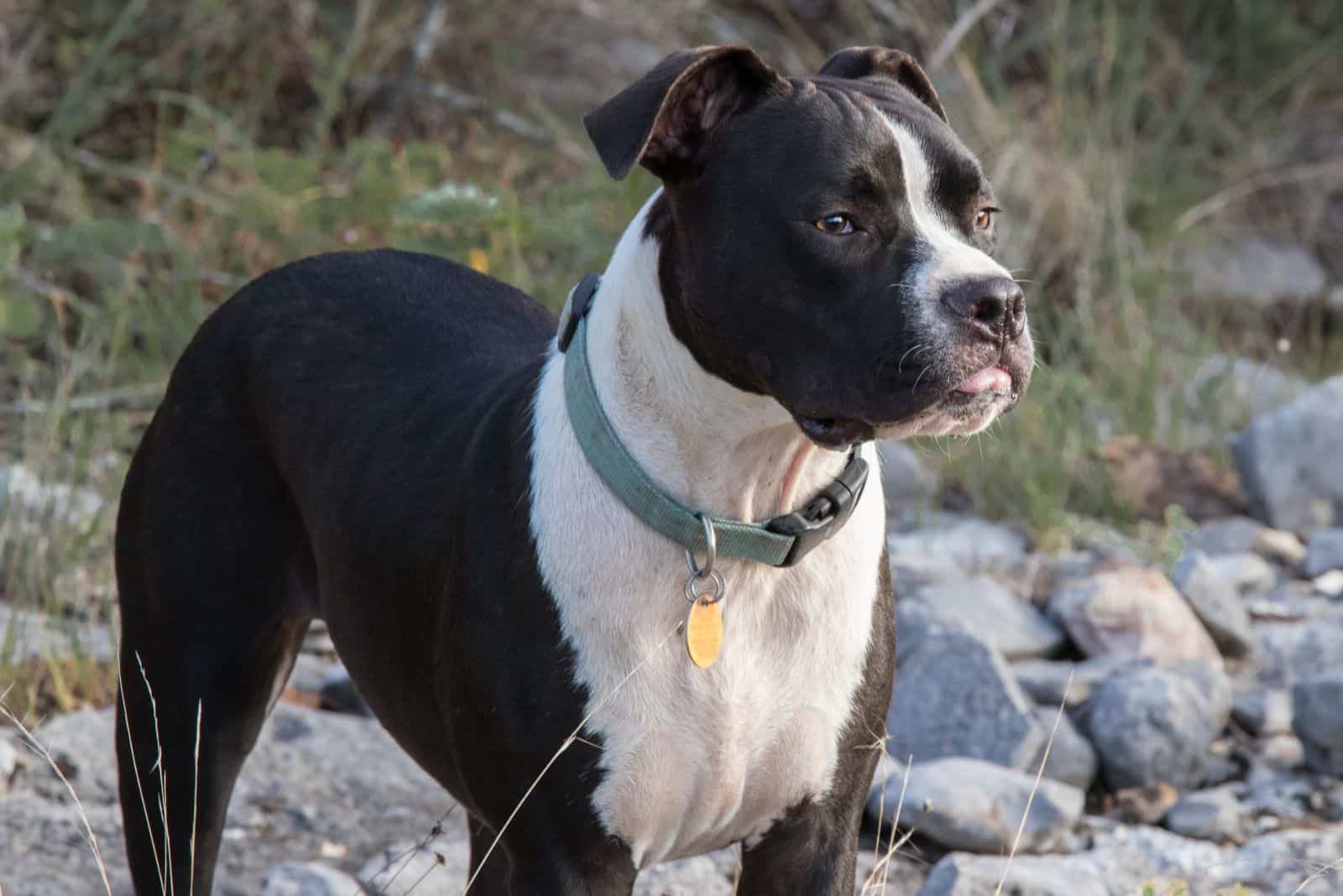How often do you get a chance to see a Valley Bulldog on the street? That’s right. These designer canines are a quite rare dog breed.
Still, due to their wonderful personality and great companionship potential – Valley Bulldogs are becoming more and more popular in the United States.
Being a mix of a Boxer dog and an English Bulldog, Valley Bulldogs, popularly known as Bull-Boxers, make decent family dogs that get along with all family members equally well.
Even though the breed dates back to the mid 1900s, and has a respectable reputation, you can still find these canines in shelters all over the U.S.
So, if you’re having second thoughts on adopting this cute puppy, you’ve come to the right place cause we’re about to throw some pawesome Valley Bulldog facts!
What Is A Valley Bulldog
Originally coming from Annapolis Valley, Nova Scotia (Canada), these hybrid dogs date back to the mid 1900s. That said, Valley Bulldogs are a quite known mixed breed in North America, and in other parts of the world, too.
These canines come from two purebred parents – the Boxer, and the Bulldog breed. Both breeds make excellent family dogs due to their kind temperament and great housing skills.
In fact, one of the reasons for Boxers being mixed with English Bulldogs is the fact that all English Bulldog mixes make decent indoor pets, as well as low-maintenance dogs in terms of grooming.
This hybrid is recognized by the following organizations:
– ACHC (American Canine Hybrid Club)
– DDKC (Designer Dogs Kennel Club)
– IOEBA (International Olde English Bulldogge Association)
– DBR (Designer Breed Registry)
– DRA (Dog Registry of America)
– IDCR (International Designer Canine Registry)
Parent Breeds
Even though this mixed breed has a quite decent history, the best way to get to know the Valley Bulldog puppy is if we start with the parent breeds first.
Both Boxers and English Bulldogs belong to a Mastiff-type of breed as they are extremely strong and powerful. However, the number one thing that disqualifies them from being true guardians and watchdogs, such as Great Danes or Pitbulls, is their size.
These canines are medium-sized dogs that don’t require as much space as their larger counterparts. That being said, both of these breeds are suitable for indoor life, which is their main advantage.
In fact, English Bulldog breeders emphasize the fact that these wrinkled, big-headed, broad-chested canines are ideal dogs even for small apartments as they don’t require much space, and they only need around twenty to thirty minutes of exercise a day.
Boxer Dog
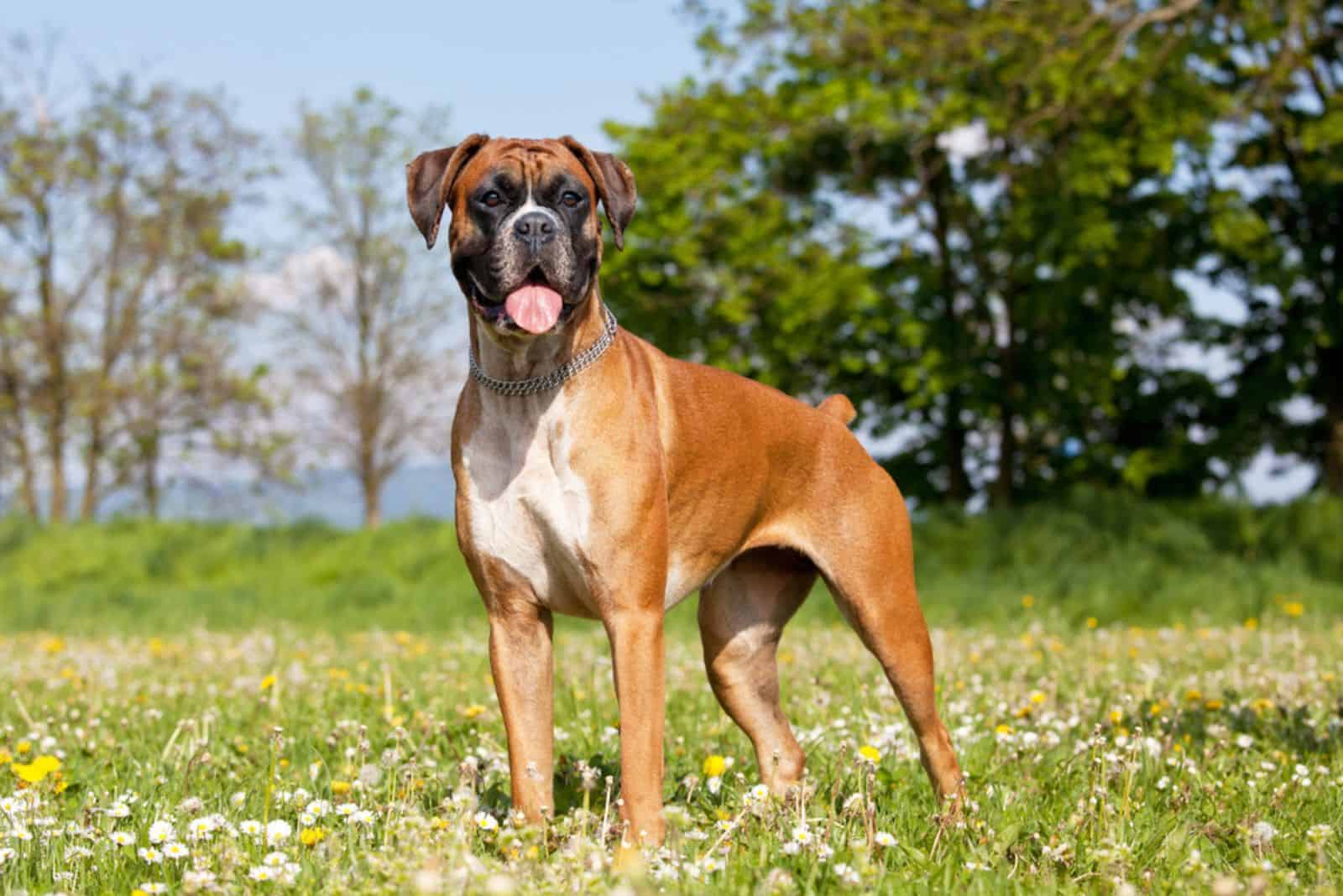
Boxer puppies are long-term members of the American Kennel Club as they were officially recognized in 1904. That said, these canines are quite popular on the soil of the United States, but the breed is widely bred all over the world.
Reputable Boxer breeders breed these canines for companionship, watchdog, hunting, and working purposes. These are all-time favorite dogs of active dog enthusiasts who love spending time on adventures.
Not so long ago, these canines were used in hunting big game, in wars, and as police dogs. The fact that they have great stamina and a fully-athletic body physique has made them favorable for high-intensity assignments.
Nowadays, Boxer canines are known as decent family members that love spending time both indoors and outdoors. Their long-term presence in U.S. households has made them laid-back, calm, and great with kids of all ages.
Another thing that adds to the fact that these canines are ideal for homes is that Boxers shed moderately. They have a short, smooth coat that needs to be brushed no more than once a week. Typically, these canines come in brindle and fawn color patterns.
The average Boxer puppy stands up to 25 inches in height, and its average weight revolves between 65 and 80 pounds. This is a quite healthy dog that lives up to 12 years.
Some health issues that Boxers can face during their lifespan are bloat, brain tumors, and joint problems.
English Bulldog
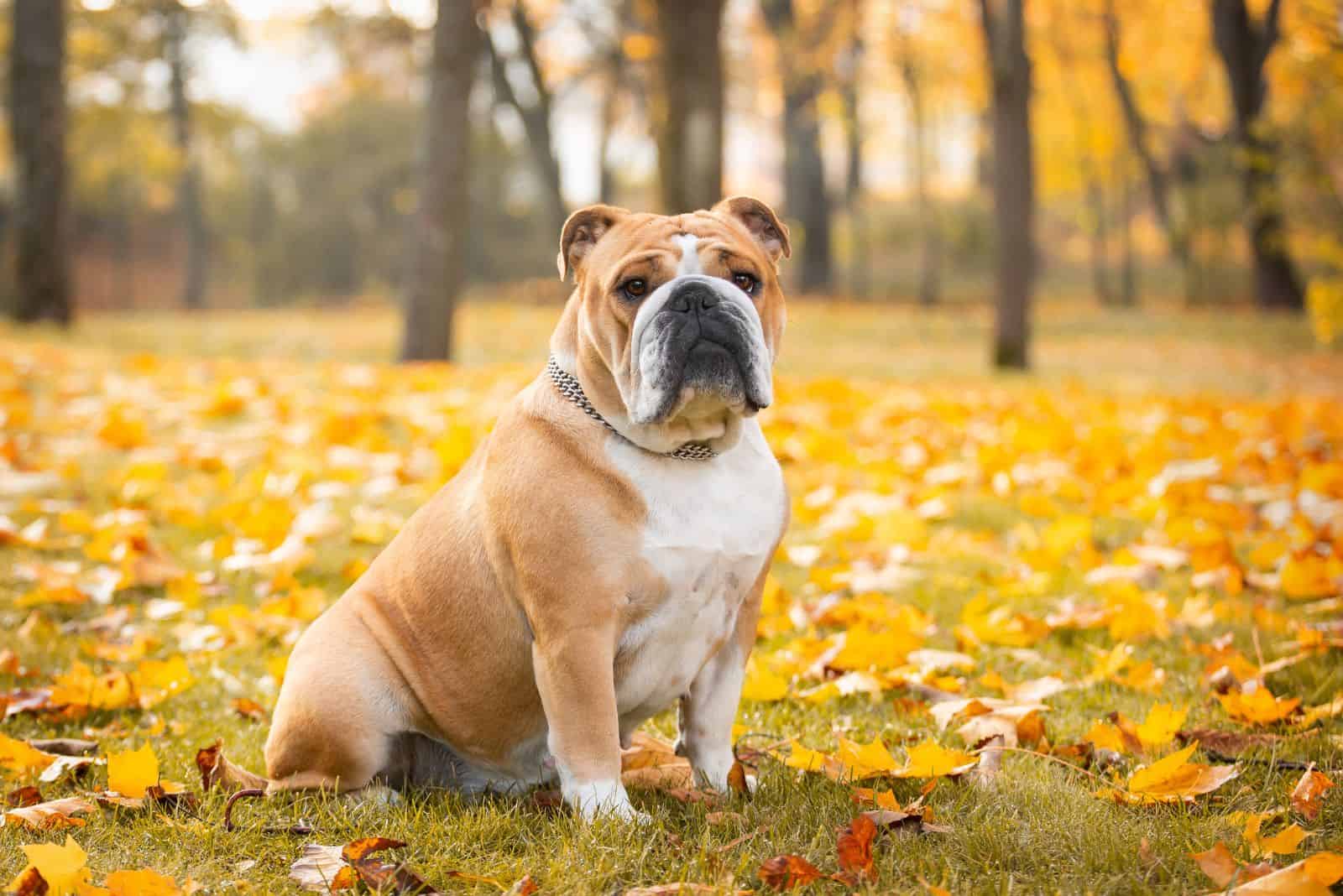
Both male and female English Bulldogs make excellent companions in all-size homes.
The fact that these canines are not as active as their Boxer counterparts has made them favorable even for small apartment living.
But, don’t be misled by their inactivity – these canines are still quite strong, and they can be extremely dangerous if not properly socialized during puppyhood.
The average English Bulldog stands between 14 and 16 inches in height, while its average weight revolves between 40 and 50 pounds. The Bulldog breed was officially recognized by the American Kennel Club in 1886, which makes this breed quite reputable.
One of the major problems that these purebred canines deal with is breathing difficulty. Due to their short, thick muzzle, these canines can become overheated in no time. That’s why English puppies don’t stand extreme weather or excessive exercise.
These puppies have a short, smooth coat that sheds moderately. They require weekly grooming and proper maintenance of their ears, teeth, and mouth. Some canines can drool excessively, which is why they require extra cleaning.
When it comes to their temperament, English puppies are known to be extremely loyal, devoted, and laid-back dogs. They love spending time indoors, which is why they are perfect for families with a calmer lifestyle.
They don’t like high-intensity exercises, long walks, or hikes. They rather prefer stay-at-home activities or short walks.
The Crossbreed’s History
The original purpose behind crossbreeding these two purebred dogs was to create an active, loyal, and healthy companion.
Their offspring, the Valley Bulldog, dates back to the 1900s when it was intentionally designed by breeders in Nova Scotia for the first time.
Unlike American Bulldogs that happen to be among the most dangerous dog breeds in the world, English puppies are much calmer, friendlier, and more sociable. That’s why breeders decided to mix this wonderful breed with an all-time worker – the Boxer.
Nowadays, Valley Bulldog puppies happen to be among the most favorable family dogs in U.S. households as they are equally active and affectionate.
On the other hand, these canines are healthy dogs with a few health issues, which was also the initial purpose behind crossbreeding.
Physical Appearance
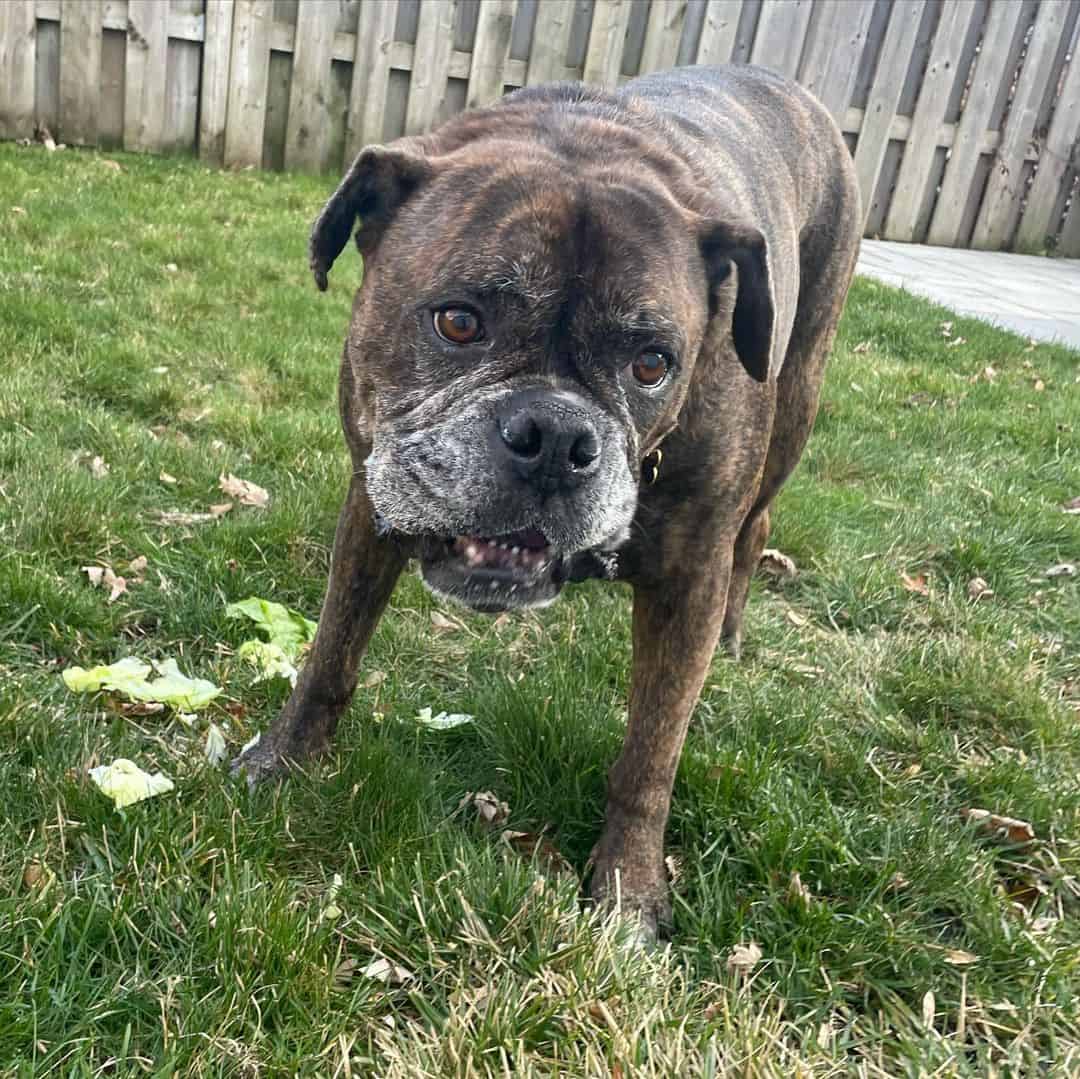
Depending on the bloodline, these mixed canines can resemble both the English Bulldog and the Boxer growth chart. That said, their average size revolves between 50 and 80 pounds, even though some Bull-Boxers can be even bigger.
Generally, these canines have a broad chest, with either a pushed in, or stuck out snout. Just like Pugs, most of these canines come with an underbite.
Due to their thick muzzle and short nose, many Valley Bulldogs are characterized by excessive snoring and flatulence, and they don’t stand extremely cold or hot weather.
Their Boxer bloodline makes them extremely athletic, strong, and durable, even though puppies with a dominant English Bulldog gene may come across as a bit lazy.
When it comes to their exercise needs – these canines will need at least an hour of good exercise during the day to remain calm and happy. Puppies that don’t exercise on a regular basis may deal with excessive weight gain and obesity.
Their trademark is their wrinkled skin in the face and tail areas. Their skin folds in an adorable manner, which is why these canines are one of the most fashionable dogs in the world.
Size And Feeding
There is no exact rule on how big these canines get. The average Valley Bulldog can be either 14 to 16 inches or up to 25 inches tall. On the other hand, the weight of these puppies revolves between 50 and 80 pounds, which still makes them medium-sized.
The fact that these canines don’t get taller than 25 inches makes them ideal for apartment living. They generally don’t require as much space as GSDs, Pits, or Rotties, which is why the possibility of them causing much trouble indoors is, therefore, lower.
The common problem that all Valley Bulldogs deal with is weight gain. That’s why owners should pay attention to their feeding chart as well as to their exercise needs.
Namely, their English Bulldog parents’ feeding chart has to be carefully prepared as these canines can gain weight in no time.
Unfortunately, the same goes for their offspring, even though Valley canines happen to be much more active than their parents.
In that regard, you should avoid table scraps and junk food as these two things can be a trigger for potential obesity and bloat (stomach torsion).
On the other hand, these canines require foods enriched with protein, healthy fats, and green fibers. The latter helps them digest food easier, and prevents the occurrence of bloat.
Unfortunately, many dogs that don’t have a well-planned feeding chart deal with bloat, heart disease, and consequently, heart failure.
Coat Type And Coat Color
If you’re wondering if these canines belong to the group of hypoallergenic dog breeds, the answer is – No! Even though they naturally have smooth, short fur, these canines are still moderate shedders.
That being said, they require at least once-a-week grooming to remain clean and shiny. Puppies that are not regularly groomed and maintained can suffer from extreme skin irritations and allergies.
That’s why cleaning them with a wet cloth, aside from brushing, is highly encouraged. Otherwise, you may deal with balls of fur everywhere in your house, which is not an easy job to clean.
On that subject – these canines also require ear and teeth cleaning in order to avoid infections and plaque. The best way to do this is right after playtime, or after a meal.
The main Valley Bulldog coat colors are brindle, fawn, red, tan, and white. Even though their Boxer parents appear solid-colored, the possibility of coming across a solid-colored Valley puppy is extremely low. These canines rather come as bi-colored or tri-colored.
Despite the fact that these puppies are not allergy-friendly nor do they have long, curly hair, their beautiful coat colors make them appear as one of the most fashionable canines in the world.
Temperament Of A Valley Bulldog
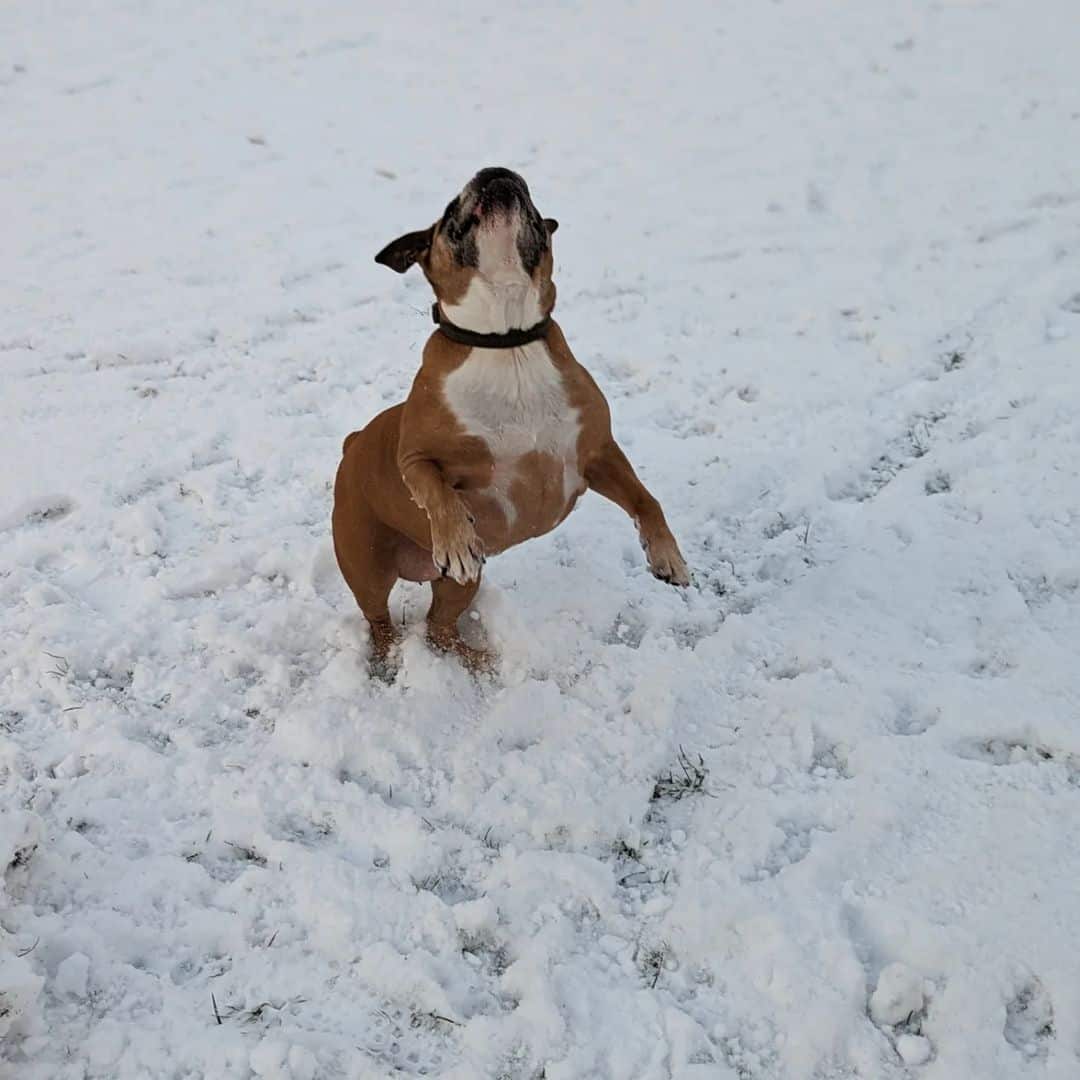
Predicting the temperament of a Bull-Boxer is not an easy subject as these dogs never come the same. However, one thing is fur sure – Valley Bulldogs are amazing pets!
In fact, their Boxer parents are known to be among the best family dog breeds in the world, which is quite the encouragement for Bull-Boxer owners.
These canines naturally do well around people of all ages, including small children. However, the playtime between children and your pet should always be supervised as these canines are generally not aware of their power.
Still, the breed has a high level of tolerance and a great sense of loyalty. These two things are great if you have a big family or other pets as Valley Bulldogs adapt to other dogs, cats, and birds in a very short time.
Coming to the other size of the coin – we need to say that despite being one of the best dogs for families, Valley Bulldogs can display a certain amount of aggression. This especially refers to stranger-oriented aggression, which is why they require early socialization.
Being a good pack leader and using positive reinforcement techniques are the two most preferred training tools to use in Bull-Boxer training.
Socialization
The best time to socialize your dog is in its early puppyhood as socializing an aggressive dog is not the best choice that you can make.
Early socialization plays an important role in any dog’s life. This also refers to Bull-Boxers. Once puppies are picked up from a breeder, you can start implementing the first socialization techniques, such as interactive games, walks, or simple play in a dog park.
If you want your puppy to learn how to distinguish enemies from friends – try bringing as many people to your home as possible. This way, the Bull-Boxer will easily adapt to new faces, voices, and scents.
These canines, despite being affectionate and friendly by default, have dominant watchdog traits in their bloodline.
That said, they will do anything to protect their loved ones, which is why helping them to adapt in various social environments is the key to a calm dog in the future.
You can always use positive reinforcement techniques, such as petting, praising, chew toys, or healthy treats. These puppies don’t respond to harsh leadership, even though they require firm pack leaders.
Knowing how to balance firm and gentle is the key to proper guidance.
Trainability
Neither Boxers nor Bulldog puppies are the easiest dogs to potty train, obedience train, or socialize. Despite their exquisite intelligence, these canines have a certain dose of stubbornness.
That said, the training process of their offspring will take a lot of time, patience, and commitment.
Valley Bulldogs need to be trained from an early age as these canines are much more stubborn once they enter adulthood. Generally, all Boxer mixes love to have their own way, which can be too much for some owners.
That’s why these canines are not always recommended for novice owners nor for people with an inactive lifestyle.
Not giving them enough exercise during the day may result in self-destruction, disobedience, and possibly aggression. That’s why you should always take into consideration their exercise needs.
An hour-long training during the day will most likely be enough as puppies with an English Bulldog gene don’t require more than that.
Aggressiveness
Even though Bulldog puppies qualify among the most aggressive dog breeds in the world, English Bulldogs don’t naturally display aggression as a primal emotion. They are rather laid-back, calm, and affectionate dogs that prefer to be petted rather than challenged.
The Valley Bulldog, on the contrary, may display a certain dose of aggression during times of separation anxiety, trauma, fear, phobia, and mistreatment.
These canines are naturally dependent as they require human presence at all times. That’s why leaving them alone for more than several hours a day is never a good option.
Furthermore, Valley canines don’t respond to mistreatment very well. If you yell, scream, or bully them – they are most likely to do the same to you!
Lastly, you should always take into account your dog’s natural fears and phobias. Some dogs are naturally afraid of loud noise, thunder, fireworks, and firecrackers. There is a pretty good chance that your Valley Bulldog will be afraid of these things, too.
That’s why you should provide them a calm, nurturing environment during storms and New Year’s eve, or keep them away from loud places. Canines that have a natural phobia may use aggression as a self-defense mechanism.
Other than that, these canines are not likely to be aggressive, even to strangers. Unlike some larger guard dogs, they are rather friendly and attention-seeking.
Housing
As we have already mentioned in some of the previous parts of this article – Valley Bulldogs are naturally good house pets! They just love spending time indoors as they are not as energetic as some other large dogs.
In fact, having a nice, comfortable nap next to their owner is one of their favorite daily activities! However, these canines do require a certain amount of outdoor exercise, too, which is why keeping them indoors 24/7 can create a behavioral imbalance.
Both male and female Boxers are extremely active dogs that seek high-intensity training. Their offspring, the Valley Bulldog, may be slightly calmer, but these canines also require a broad set of daily activities.
The difference, though, is that Bull-Boxers can perform those activities inside the house. This is a medium-sized dog that doesn’t require as much space as a GSD or some other large breed.
These canines will rather seek entertainment in chew toys as they are enthusiastic chewers. Just make sure to get them durable toys.
On the other hand, properly-trained Bull-Boxers are most likely to get along with other pets. Even though the breed itself is quite territorial, they can be trained to respect their other housemates, too.
One of the downsides of having a Bull-Boxer, though, is their moderate shedding. Despite having a short, smooth coat, these canines will still leave occasional hair trails all over the house.
Health Issues
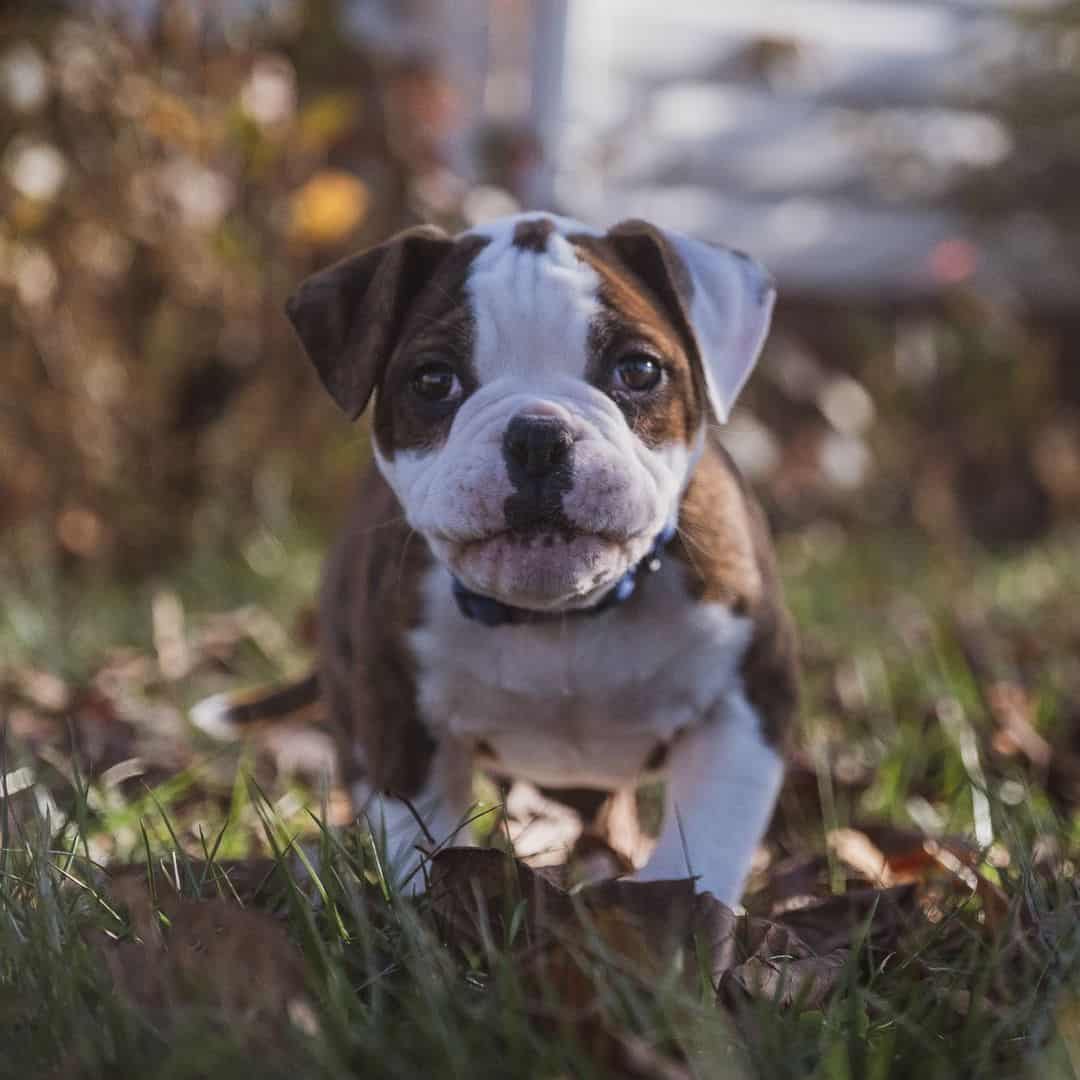
Neither of the Bull-Boxer’s parents is considered to be among the healthiest dog breeds due to their natural breathing difficulties, occasional bloat, and skin problems.
Still, these puppies have a respectable life expectancy as they can live up to 12 years. However, some dogs can live significantly shorter due to their hereditary issues, such as heart disease.
There are two things that you can do to make your dog’s life better. The first one is having a well-organized diet. Giving your dog the best-quality food will reduce the possibility of weight gain, and at the same time, stimulate your dog’s proper growth.
The second thing is exercise. Even though these canines have a dominant gene of English Bulldogs, which are known to be lazy at times, they still need moderate exercise to remain as healthy as possible.
Breathing Difficulties
If you’re wondering why your puppy is breathing so fast, the answer may be – genetics! These canines have a naturally thick and short snout, which makes their breathing more difficult than in other dogs.
In fact, these canines are popular for their snoring at night, which, at times, can be extremely overwhelming.
Keeping your Valley dog overheated is never a good thing as it can easily faint. Valley Bulldogs don’t stand extreme hotness nor extreme coldness. They rather prefer being in a moderately warm environment.
Breathing difficulties are probably the most common health problem that any Bull-Boxer can have.
Skin Problems
These canines don’t need to be bathed unless they get extremely dirty. The reason behind this rationale is the fact that Valley canines have extremely sensitive skin that is susceptible to allergies, infections, and irritations.
If you notice dry, flaky skin in your dog – revise your grooming methods as well as your grooming tools. Sometimes, these canines can get an allergy from dog shampoos as they can be allergic to certain ingredients.
One of the major reasons for dry skin in your dog is the environment. These canines require a moderately warm climate as they don’t respond well to coldness nor to hot weather.
Obesity
Obesity is one of the most common health problems in these hybrid dogs. Their English Bulldog parents are naturally prone to excessive weight gain as they are not very active.
Unfortunately, the same goes for Bull-Boxers. Therefore, you should always pay attention to their feeding chart as well as to the type of food these canines are eating.
Always try to stay away from poor-quality dog food brands as well as from table scraps and junk food. Instead, try giving your dog food enriched with biological meat protein, healthy fats, and green fibers.
Additionally, you should meet the exercise requirements of your Valley canine as these dogs need at least an hour of moderate exercise on a daily basis.
Bloat
If your dog eats big portions of food voraciously – get ready to deal with bloat. Bloat (or stomach torsion) happens as a result of bad dieting as well as eating unhealthy foods.
These canines require one to two meals a day in their adulthood phase. However, you need to pay attention to the amount of food that you give them as eating too much all at once can trigger bloat.
This health condition is characterized by a swollen stomach, lethargy, stomach ache, lack of appetite, panting, and general lack of energy. Some canines are even unable to drink water during bloat.
In case your dog is suffering from stomach torsion – you must visit a veterinarian immediately. Untreated bloat can have deadly repercussions.
Heart Disease
Unfortunately, heart disease is not that uncommon in these canines. In fact, one of the most common causes of death in their English parents is untreated heart disease. That’s why you should always pay attention to your dog’s healthcare.
That said, regular vet exams are a must if you want to keep your puppy healthy. Furthermore, not giving your dog adequate food can have a negative impact in the long run. Consequently, puppies with bad dieting are more likely to deal with obesity and heart problems.
The advice that any reputable English Bulldog breeder will give to future owners is to feed their pets with the best dog food on the market. The same goes for their offspring as puppies with a dominant English Bulldog gene are more prone to heart disease.
Valley Bulldog: Price
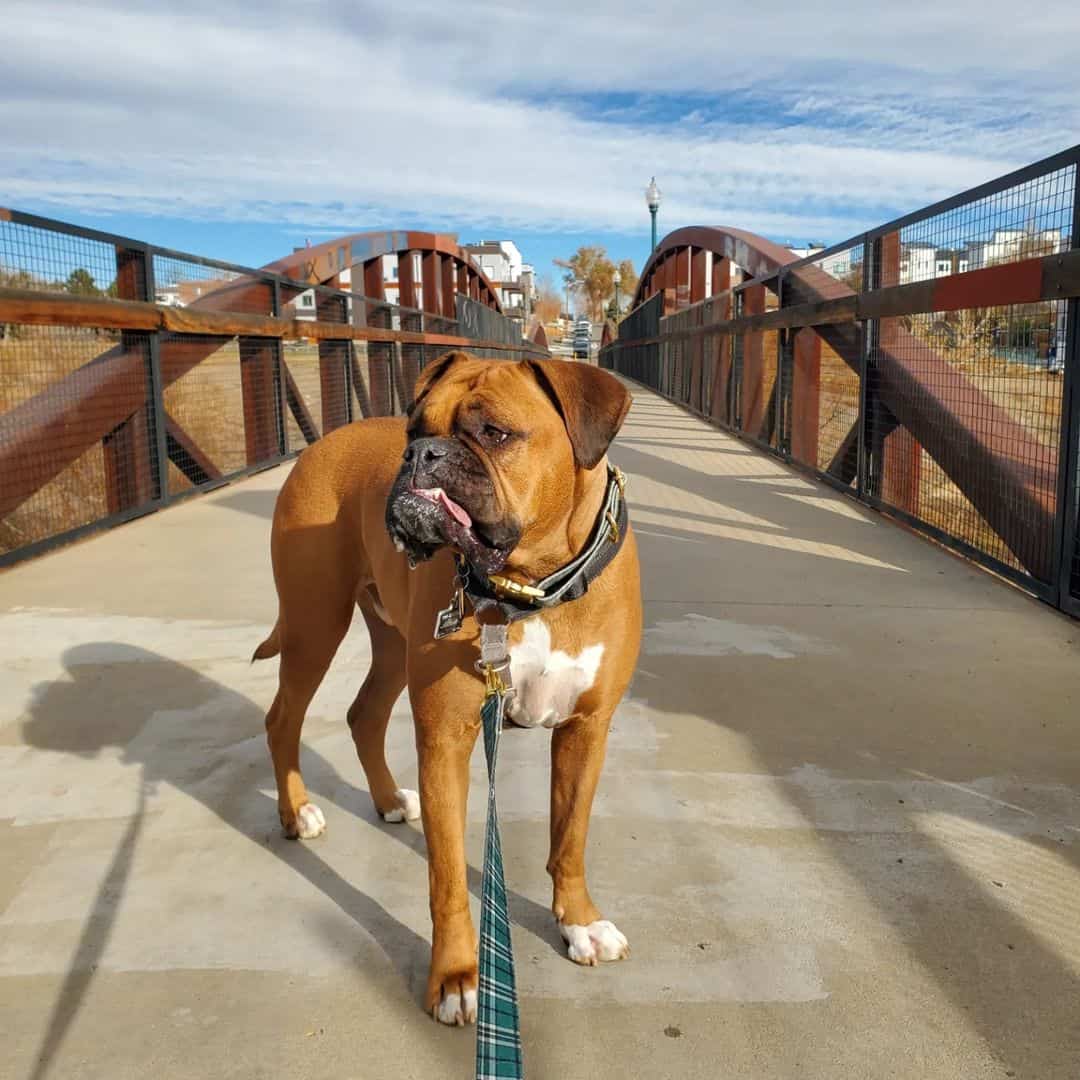
Predicting the price of a Valley Bulldog is not a walk in the park as the average price that you can expect to pay for these puppies begins at $500 and it ends at $2000.
However, the first thing that you should pay attention to when buying this hybrid is to get it from a reputable breeder. This way, you will spend more in the initial phase, but you are most likely to save tons of money in the future.
Puppies purchased from reputable breeders generally come with registration papers (in one of the hybrid canine registries), DNA tests, vet papers, a microchip, interactive dog toys, and the first pack of food to start the adaptation phase.
On the other hand, if you decide to buy a puppy from a less reputable breeder or a shady puppy mill – make sure you subject it to a thorough vet exam as soon as possible.
Other Costs
There are always some additional costs that you can expect to have when buying a puppy for the first time. For starters, you want to buy puppy insurance for your Valley companion as these canines come with a plethora of health issues.
This way, you can save a lot of money as treating a dog without insurance can be extremely expensive.
Furthermore, you can expect to buy a leash and a dog training collar as these two things are necessary during the socialization phase of your puppy.
Getting an appropriate dog bed will be a smart choice, too, as these canines love spending time laying around the house. This way, you will prevent your furry friend from leaving so many hair trails all over the floor, couch, or your bed.
Buying a suitable litter box is an unavoidable thing in having a dog as an indoor pet. The good news is that litter boxes are generally not that expensive as you can buy one for just $20 or so.
Lastly, if you’re an enthusiastic traveler, and you want your dog to accompany you in your quests – getting a dog passport will be a must. However, the cost of getting one depends on the state that you’re living in.
The average price that you can pay for a dog passport revolves between $100 and $1000.
FAQs
For starters, the most obvious difference between these two is the price. The English Bulldog price revolves between $1500 and $4500 on average, while Valley Bulldogs cost significantly less. An average Valley dog costs between $500 and $2000.
The other basic difference is their temperament. While English puppies are much more laid-back and calm, their offspring can be overly active and attention-seeking.
Furthermore, Valley canines are generally more athletic and durable, and they need a lot more exercise during the day than English Bulldogs.
Definitely, and most certainly – yes! Even though they are not a lap dog breed like Frenchies, these canines are perfect for sporting families and people with a more active lifestyle.
They are naturally affectionate, loyal, protective, and quite vocal dogs that love spending time in their home.
Final Thoughts
The Valley Bulldog puppy, despite not being as famous as some other family dogs, is the perfect choice for families that love spending time outdoors.
These hybrid canines are the perfect mix of their parents as they kept the attentiveness of their English parents, and they still make excellent walking, hiking, and adventure companions, which is a trait of their Boxer ancestors.
If, by chance, you decide to get one – make sure to check their bloodline first as there are a plethora of unreliable breeders out there. If, however, you already have one – I hope that this piece has presented you with some useful parenting tips.
Read more: Boxer Great Dane Mix: A Goofball, Yet A Serious Guard Dog
